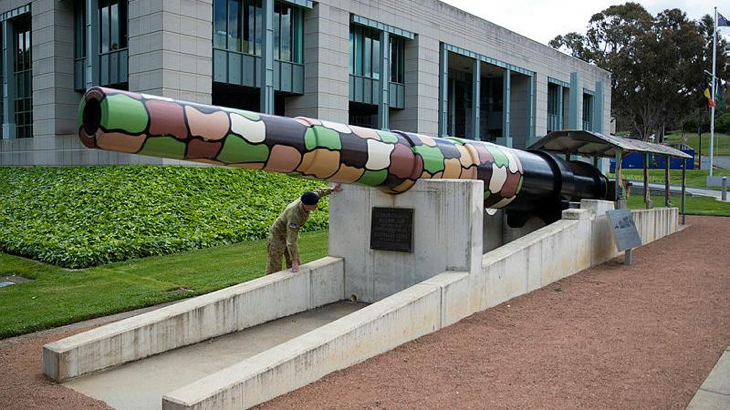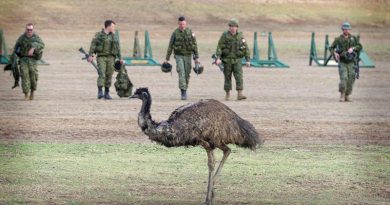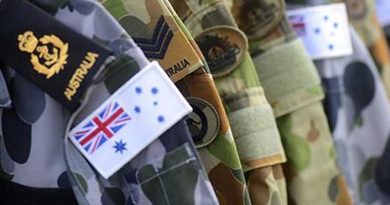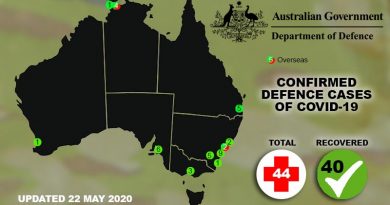Big gun with an even bigger story

Firing 300kg shells more than 25km, this astonishing piece of hardware is described as the finest trophy captured by any nation during the Great War.
CAPTION: An Australian soldier inspects the barrel of the Amiens Gun located at the Australian War Memorial, Canberra. Story and photo by Private Nicholas Marquis.
At 44 tons and spanning the length of a cricket pitch, the Amiens Gun has sat on the lawns of the Australian War Memorial since 1960.
Built by Fredrick Krupp in 1904, the ‘big gun’ – originally a naval cannon – was repurposed as a railway mounted gun on the Villers-Bretonneux frontline and rained down a multitude of 28cm shells on the city of Amiens.
At half the height of a man, the sheer size of the brass shell casings is enough to understand the power it unleashed.
Nicknamed Bruno, the gun was originally fitted to SMS Hessen, the third of five Braunschweig-class battleships of the German Imperial Navy in 1902.
Five rounds were put through the barrel during the Battle of Jutland, the war’s largest naval engagement Hessen was disarmed in 1916 to make way for more modern ships.
Two years later, the repurposed railway gun bombarded allied positions during the three-hour Battle of Amiens.
Australian Gunner J.R. Armitage wrote in his diary: “All hell broke loose and the world was enveloped in sound and flame. The ground shook.”
31st Battalion was advancing on the frontline when they noticed a railway train fire a large gun from a carriage.
After seeing it fire several shots, a plane circled above and dropped bombs neutralising the train.
Engineer Lieutenant George Burrows received a Bar to his Military Cross after he and two sappers coupled the gun and ammunition wagons to a burning train to bring it within Australian lines.
David Pearson, Senior Curator at the Australian War Memorial, said this trophy was significant in Australia’s involvement on the Western Front.
“At the point where the gun was captured, this was seen as the black day for the German Army,” Mr Pearson said.
“It’s a bit contested about who actually knocked it out. But what we do know is 31st Battalion captured the ground.”
The captured gun was displayed in Paris for some time, where it bore the markings “Captured by the A.I.F.” before it was transported by ferry to England and then to Sydney.
“It had to go through the trophy committee to be allocated to Australia,” Mr Pearson said.
“They assessed if we had a valid claim for the weapon.
“When it first came to Australia, it was at Central Railway Station.”
NSW was the only state at the time that had the same rail gauge as the gun.
It sat at Central Station until upgrades and sinking railway tracks required it to be moved in 1923.
Its home for 16 years was in Canberra, at Kingston railway station, where it sat before being moved to Adelaide.
The vibrant coat of camouflage paint on the gun’s remnants represent the original colour found under multiple layers.
“The Germans used lozenge-type camouflage and changed them depending on the season,” Mr Pearson said.
“When the barrel was repainted, it was done based on colours found underneath.”
In 1942 the weapon was dismantled, the carriage was moved to Port Wakefield, South Australia and it was used to test fire naval barrels for WWII.
It was seen as too expensive to bring back to Canberra, so the carriage was cut up in the 1960s.
The gun was meant to be put back together after disassembly but everything was melted for scrap except the barrel, which has been outside the War Memorial since the 1960s.
.
.

.
.






It always get’s to me how the Army didn’t see the value of returning the carriage to the AWM after they borrowed it in WW2. This would be up there with the German WW1 tank as the Museum’s most prestigious display if it still existed. How short sighted was the scrapping and how sad it can never be undone. At least we have the gun itself to remember one of the greatest days in Australian military history.